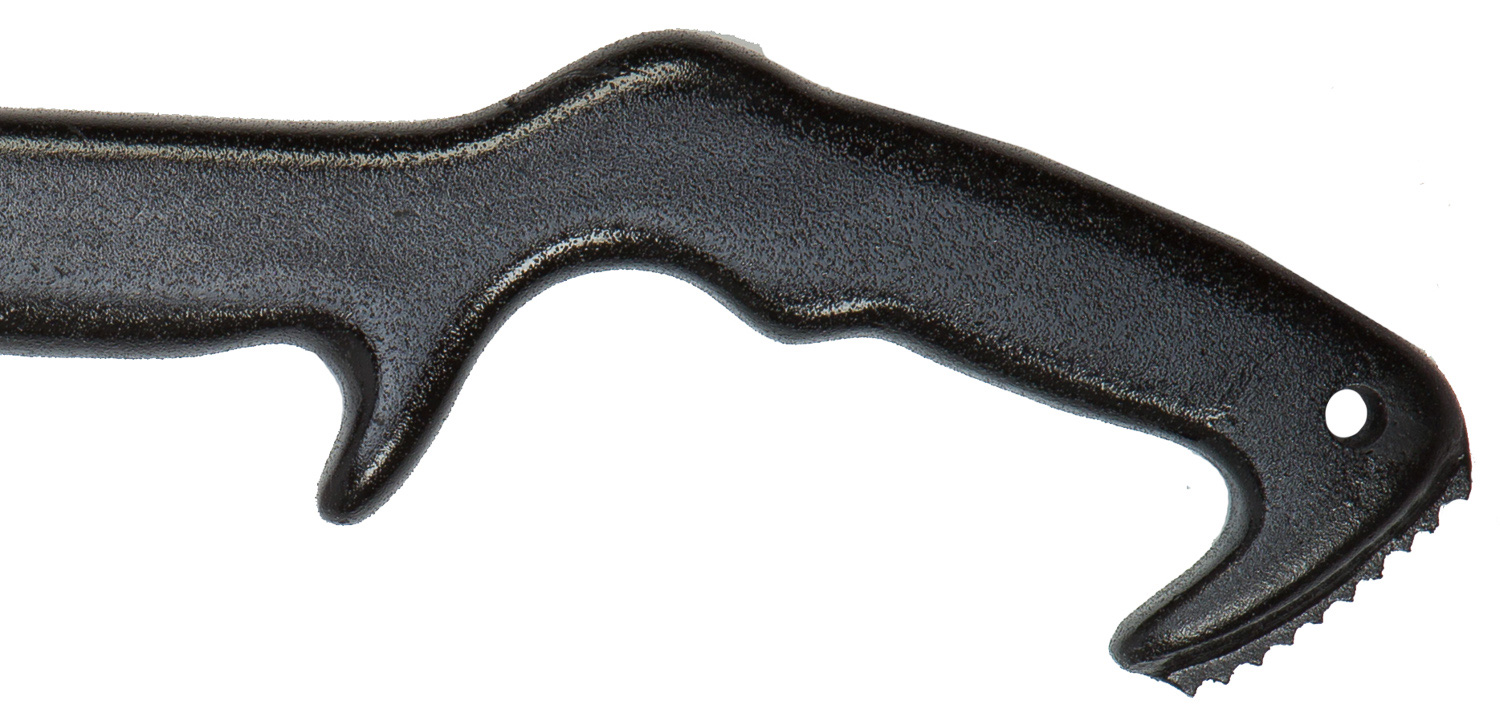Trango introduced the Kestrel ice tools in 2020, and they oozed the high-performance potential of carbon fiber. But I needed to know if they’d perform in high-stakes ice climbing.
Big backcountry ice climbs require a different mentality about ice tool weight than single-pitch ice cragging at parks like the Ouray Ice Park or climbing in canyons with short approaches. Weight matters, as every extra ounce carried across rugged, snow-covered terrain and up big ice can detract from the performance and overall enjoyment of the outing.
Trango utilized carbon fiber and Kevlar in the Kestrel ice tool shaft, keeping the weight low and concentrating the mass in the head. The wonder materials also provided benefits beyond lightness. All these factors made the Kestrel ideal for big backcountry ice with long, arduous approaches.
I brought three sets of ice tools into very remote locations in Alaska a few weeks ago, searching multipitch first ascents. The Kestrels were far and away my favorite of the trip. Let me tell you why.
In short: The Trango Kestrel ice tool proved ideal for waterfall ice routes up to WI5+. The further out and taller the routes were, the more advantageous these tools became.
The Trango Kestrels Are the Perfect Weight
Heavier tools, especially those with more significant head weight, make sticking swings easier. The greater momentum generated by greater mass results in less energy spent getting a bomber stick. And added weight can result in a much more pleasant and confidence-inspiring swing and less rebound if you glance off.

But the negative is more total energy spent schlepping those tools across and over the mountainous terrain that usually surrounds big ice climbs, which repeats ascending the frozen beasts.
I had one set of heavier tools than the Trango Kestrels and one that was lighter. And, man, did Trango get the total mass and head weight right; the Kestrels repeatedly proved themselves to sit at the very happy medium with a verified weight of 1 pound, 3 ounces per tool with the included 2.3-ounce head weights.
Trango Got the Grip Right
Another crucial factor is the grip and choke grip size. Again, Trango hit the happy medium with the Kestrels.
I had one set of tools with a larger grip and one with a smaller grip. The more significant grip felt too big with gloves appropriate for 10- to 20-degree weather, while the smaller grip was harder to use when a perfect swing wasn’t in the cards.
When grips are too large, I have to apply more grip force to feel secure. Grips too small require the same to prevent head twisting when impacting ice off-angle. Both erode confidence, which usually leads to overgripping and an early start to arm pump.
Trango used the same size on the choke-up grip as the main grip, which I preferred. Some ice tools have a smaller main grip and a larger choke-up grip, which I know others may prefer.
But I like the consistency between the two grips, especially when I hang off a single tool and switch up hands to shake out. I know what to expect no matter how many times I switch my hands out.

The texture of the outermost coating on the Trango Kestrels was perfect. Carbon fiber and the associated resins and coatings are usually smooth and slick. I have to add tape (which changes the grip size) to feel secure with winter gloves on carbon tools.
But the built-in texture of the Kestrels was perfect for leather-lined gloves; I felt confident with less grip force, and preventing twisting upon impact felt so much easier than with other carbon-shafted models.
Outstanding Geometry and Weight Distribution for Vertical Ice
The bends, angles, weight distribution, and shaping of ice and mixed iced tools seem like alchemy mastered by a few. Getting the head/pick angle, relative grip position/angle, and shaft shaping defines how the tool feels and functions.
And the total weight and distribution of this mass affect the swing and penetration of the pick. This blend of characteristics is what makes ice tool design difficult.
Again, Trango somehow hit the sweet spot.
Our objectives ranged from Water Ice 3 (WI3) to WI5+, and of the three tools I had, the Trango Kestrel was the only tool that performed well across this grade range. The other two tools struggled on lower angle ice.
On vertical WI5, the Kestrel’s angles and shaping made them an extension of my arms. I could pick a target and hit it first try with a solid stick with favorable ice conditions.
I never bashed my knuckles or hung the shaft on a reasonable bulge or feature when vertical. And when the going was easier on lower angle terrain, the Kestrel was the one tool that kept my knuckles from hitting without compensation.
The carbon/Kevlar shaft allowed Trango to concentrate weight at the head, and the ergonomics permitted natural swings across all the angles of ice I climbed between WI3 and WI5.
The only time I strayed from my natural swing was on an overhanging WI5+ section with mushroom formations. I had to bring the shaft up to match the placements behind the mushrooms, but I would have to do that with any tool.
The choke-up grip position and angle in relation to the pick also proved excellent. When choked up, I didn’t have to concentrate on not pulling out as I do on some other ice tools. Trango applied the grippy texture on the entire shaft, so no matter where I was gripping the Kestrel, the helpful friction was there.
Trango Kestrel: Full Carbon Shaft
Low weight is not the end-all, be-all for ice tools, but the carbon/Kevlar shaft of the Kestrel undoubtedly helps. But what was more palpable was the vibration-damping capability of carbon fiber.
Much like carbon fiber bicycle frames, the material damps vibrations much differently than ferrous materials. Compared to steel, lower amplitude, higher frequency vibrations were absorbed well, while the impact of larger amplitude vibrations had the “edginess” reduced.
This characteristic was most palpable and improved comfort on harder, more brittle ice in colder conditions. And although I didn’t have a way to quantify it, the overall vibration-damping ability of the Kestrels likely saved me energy over a day and through the week.
Nitpick: Although I climbed leashless most of the time, on huge routes I prefer to use an umbilical. The Trango Kestrel doesn’t have a direct clip-in point at the lowest pommel, but it does have holes for an accessory cord.
What About the Pick?

I modified the included ice-specific picks (Trango sells mixed picks for the Kestrel) as I do on almost all my ice tools. To ease removal, I file the first tooth down to be the same height as the next one.
After this very slight modification, I didn’t notice the pick; this is to say, it performed excellently on waterfall ice the entire week. When ice conditions hinted at first swing sticks, the Kestrel picks were 100% on point. On ice where I already knew multiple swings were necessary and I was “preprogrammed” to do so, the picks reacted and stuck as expected.
Only a few times over the week, I noticed the picks being difficult to remove when driven further than necessary.
Zero complaints on the pick.
Trango sells a mixed pick and hammer/adze kits for the Kestrel.
Conclusions
Trango hit a home run for waterfall ice climbing up to WI5+ and alpine climbing.
The weight distribution and low mass saved energy on approaches and big ice. The carbon/Kevlar shaft also damped vibration for improved comfort and additional energy savings.
The ergonomics proved excellent over a wide range of angles, and the traction provided by the finish was second to none.
The kicker is the price. At $495 each, a set of Trango Kestrels unloads the wallet. But the carbon/Kevlar composition adds both material and labor costs. For comparison, the popular Petzl Nomic with an aluminum shaft costs $300 each. The carbon-shafted Grivel Dark Machine has an MSRP of $420.
I am fortunate to have plenty of ice tools from which to choose. We didn’t bag our big objective on this trip. It’s a colossal ice formation that is difficult and dangerous to access and promises pitches of WI5. It would be the first ascent. The stakes are high.
And unless something better comes along, the only tool I’ll take next year is the Trango Kestrel.








